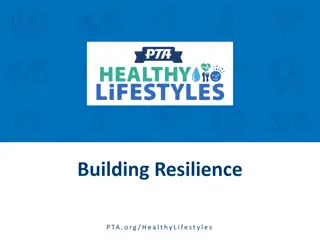Understanding Hybrid Threats and Resilience through Civil Preparedness
Exploring the concept of hybrid threats that combine external threats and internal vulnerabilities, this academic viewpoint by Ramon Loik emphasizes the importance of civil preparedness in building resilience against crises. It delves into aspects such as target selection, active influencing, and the chain of resilience, highlighting the need for multi-level resilience encompassing societal resources to withstand and recover from shocks effectively.
Download Presentation

Please find below an Image/Link to download the presentation.
The content on the website is provided AS IS for your information and personal use only. It may not be sold, licensed, or shared on other websites without obtaining consent from the author. Download presentation by click this link. If you encounter any issues during the download, it is possible that the publisher has removed the file from their server.
E N D
Presentation Transcript
Hybrid Threats and Resilience through Civil Preparedness: An Academic View Ramon Loik Research Fellow International Centre for Defence and Security ICDS Security and Resilience Programme
(In-)Security and Hybrid Threats Security can be understood as combination of external threats and internal vulnerabilities (B. Buzan). Hybrid threats target vulnerabilities of society both externally and internally (domestically): (1) Identification of vulnerabilities (Target Selection) (2) Targeting of vulnerabilities (Active Influencing) (3) Dependency Building (4) Weaponizing of dependencies (5) Power Projection follows ...
Active Influencing: STATE (X) Proactive Interests (Intention) Resources Timing State- sponsored proxies Intrest- driven proxies TARGET STATE / SOCIETY (Y) Reactive Fragmentation Polarization Cleavage Escalation Crises
Complementary Perspectives: Chain of Resilience 1. Political, Economic and Diplomatic 2. Military / Defense (related concepts such as asymmetric and unconventional warfare) 3. Intelligence & Counter-Intelligence 4. Communications (incl. Cyber) Security 5. Civil Preparedness & Crises Management Perspective
Conceptualizing Resilience Resilience should ensure sufficient level of civil preparedness households, communities, industries, infrastructures and state(s) to resist and recover from crises. Resilience is multi-level and should comprehensively binding together all societal resources available to withstand and recover from large-scale shocks. Risks ~ (External + Internal Threats Rating) / Consequences Rating x Vulnerability Rating
Labels of Comprehensive Resilience-Building Source: Structure adapted form M ller (2012: 7). Content developed by Loik Referent Objects Values at Risk Label Sources of Threats Optional Forms of Threats The state, constitutional order, legitimacy of governance Sovereignty, territorial integrity, political order and stability Other states, sub- state actors, organized asymmetric actors Military attack, large-scale aggression, serious flows of organized crime, large- scale cyber attacks, etc. National security Societal groups, nations, cultural order, demography National unity, identity, cultural continuity States, illegal immigrants, conflicting aggressive cultures, etc. Genocide, ethnic cleansing, large-scale discrimination, large-scale illegal immigration flows, isolation, etc. Societal security Individuals, groups Survival, safety, health, quality of life Other states, criminal groups and - individuals, turbulent globalization, etc. Crime, under-development, hunger, poverty, acts of terrorism and ohter organized crime, etc. Human security Individuals, groups, mankind, territories, ecosystem Survival, safety, health, quality of life, sustainability Population growth, resource depletion, wasting economy, etc. Epidemics, pandemics, resource conflicts, large- scale pollution, extreme warming, destruction of habitats, etc. Environ- mental security
Example: Estonian Concept for Civil Protection 2nd Pillar: Protection of Population 1st Pillar: Public Awareness- Building 3rd Pillar: Response and Recovery Rapid Response Early Warning System (EWS) Education Supplies Training Programmes Crisis Communication Recovery Risk Communication Self-Resilience of Individuals and Households Mass-Evacuation Sheltering
Estonian National Crisis Management System Civil Emergencies (Emergency Act) National Defence Crisis (National Defence Act) Emergency management authority Government / Prime Minister C2 COORD Government Crisis Committee Government Security Committee Risk Assessments Joint Threat Assessments CAPABILITY PLANNING Sectoral Development Plans National Defence Development Plan CONTINGENCY Emergency Response Plans National Defence Contingency Plan PLANNING
Assistant Police Officers (incl. Candidates) Voluntary Maritime Rescuers Voluntary Rescuers Status Total Persons in MoI Civil Reserve 1110 503 2200 3813 Engaged with EDF or EDL Amongst them in active military service (KVTS 7) Amongst them conscripted (KVTS 5 lg2) Active member of EDL Active member of Women`s Voluntary Defence Org. (EDL) Employment relationship with EDL 406 120 294 820 27 9 27 63 11 3 3 17 304 96 236 636 32 4 14 50 32 8 14 54 Overlap 406 120 294 820 Corrected/Real Civil Reserve 704 383 1906 2993 Primary Data Source: Estonian MoI
CapabilityBuilding Approach What kind of resilience capabilities we need to improve Cyclical Goal Setting Evaluation of cross- sectorial shortcomings Preparedness Recommendations Risk Analyses: Identification of challenges and needs Priority Setting Capability Analyses: Identification of needful cooperation resources and tasks Task Setting Capability Assessment: Testing of needful cooperation resources and tasks Action Improvement
Thank you & Discussion ramon.loik@icds.ee























